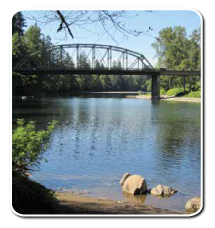Our Source
The Clackamas River begins on the slopes of Olallie Butte, a High Cascade volcano. The river flows 82.7 miles from its headwaters (elevation 6,000 ft) to its confluence with the Willamette River near Gladstone and Oregon City (elevation 12 ft) and is made up of 16 sub watersheds.
Click here to go an interactive map of the Clackamas River watershed.
To learn more about the history of our watershed check out this video https://youtu.be/4jn-Q6LPU3s

The watershed drains more than 940 sq miles or 600,700 acres. More than half of its length it runs through forested areas over rugged terrain. The lower reaches flow through agricultural and densely populated areas. The watershed crosses two counties and includes federal land administered by the US Forest Service and BLM, state land, and private land.
Unlike the Bull Run Watershed, which is federally owned and managed by the City of Portland, 72% of the Clackamas watershed is publicly owned, 3% is tribally owned, and 25% is privately owned. The watershed can roughly be divided in half, with nearly all of the upper watershed in the Mt. Hood National Forest and managed by the USFS. In contrast, most of the lower watershed is privately owned. The area in between the national forest and the lower watershed includes parcels of land owned by private timber companies and the BLM. The estimated population within the watershed in 1995 was 63,702.
The Clackamas River supplies high-quality drinking water to over 300,000 people in Clackamas and Washington Counties and is targeted in the Regional Water Supply Plan as a source to meet future demand.
There are five municipal surface water intakes on Clackamas. They include:
- City of Estacada
- City of Lake Oswego/Tigard
- Clackamas River Water
- North Clackamas County Water Commission
- City of Gladstone
- Oak Lodge Water Services
- Sunrise Water Authority
- South Fork Water Board
- Oregon City
- West Linn
PGE operates three hydroelectric dams on the Clackamas River mainstem: Faraday (just east of Estacada), River Mill (west of Estacada) andNorth Fork (upstream from Faraday). These dams have adult fish passage facilities; Faraday and River Mill also have juvenile fish bypass facilities. The Oak Grove Fork of the Clackamas river has two dams, at Lake Harriet (23 miles east of Estacada) and TimothyLake.
In 1988 Congress incorporated approximately 50 miles of the Clackamas River into the Federal Wild and Scenic River System. Four sections of the River are also designated as State Scenic Waterways. The purpose of these designations is to manage designated segments by protecting their outstandingly remarkable values and maintaining and enhancing the natural integrity of river-related values.
The watershed supports naturally spawning anadromous fish including steelhead, chinook, coho salmon, as well as lamprey and sea-run cutthroat trout. It also provides important habitat for many wildlife species, both game and nongame, and offers a wealth of recreational activities such as fishing, hiking, camping, white water rafting, kayaking, and hunting.

1) Naturally spawning and anadromous salmonids.
The Clackamas supports a variety of salmon species.
2) Land Use.
Land use impacts can increase pollution runoff, sediment loads, and water temperatures.
3) Urban Growth.
Impervious surfaces increase the impact of stormwater runoff.
4) Water Quantity.
Water for people must be balance with water for fish.

![]()
Watershed Protection
![]()
Drinking-Water Protection
![]()
Watershed Programs
![]()
Water Quality
![]()
